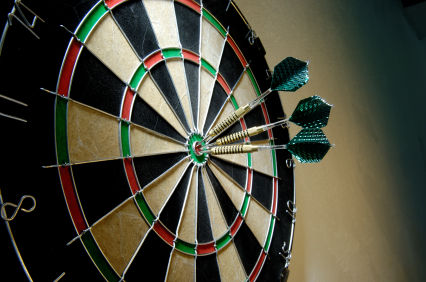It’s a good idea to do a goal setting lesson or activity every year. Among the most favorable and effective methods for students usually consist of a graphic organizer. The students write out their immediate and long-term goals, including perceived barriers, and how they plan to overcome these challenges. Students especially enjoy writing in these graphic organizers because of the visual element.
You can then have your students individually discuss how they plan to overcome their personal barriers. Admitting personal challenges can be daunting for students, but teaching them how to think of solutions to their own challenges is actually quite exciting and motivating for them.
Last year, we took this goal-setting process a step further, and made PowerPoint presentations about their individual goals. While using PowerPoint to provide a positive step in the right direction, I recently found a significantly more effective method.
Research tells us that we are far more likely to accomplish our goals with a support system that believes in us. A very powerful approach focuses on using social support systems in your classroom, students’ classmates, as a support and accountability system for each other. From a teacher’s perspective, this means that students would first make individual goals. They are then paired with a classmate, supporting each other in achieving their goals. Not only is a student provided with healthy and positive support to reach their own goals, but they also learn secondary lessons through the primary goals of their classmates.
Socially supported goal setting can be done a few different ways, depending on what would work best for your particular class:
1. Students can quickly jot down three goals they would like to achieve in 2015. Teachers should teach students that goals should be measurable, specific, and have a set deadline. The goals do not have to be academic or specific to your class, we are teaching the whole child. They may need some help from you about making goals specific.
Example of a goal that is too general: Do my work in Geometry
Example of a specific goal: Earn a 3.5 in Geometry for Quarter 3, which ends on March 2nd.
2. Ask them to highlight or circle the goal that is most important to them. The goal doesn’t have to be academic. Remember, if they are having a problem at home, solving that can help remove distractions and promote a more open mind for their academics. This is the goal they will focus on.
After students fill out individual goals you could pair or group them in a few different ways. (Partnerships of two to three would be powerful for this type of lesson.)
- You could group them with similar goals so they could support each other.
Example: Two students with low math test scores could start studying together and quizzing each other.
- You could group them with different type of goals so two students don’t further sink together.
Example: Two students with low English scores both sit together and talk about how much they dislike English class and continue to receive low scores.
- You could group a popular student with an isolated student to strengthen social connections in class.
- You could have students write down their most important goal on a piece of paper in large font. Have them walk around the room without talking while reading each other’s goals. When they see somebody they feel they could support, for whatever reason, they stop and link arms with them. When three or four arms are linked they stop moving. These are their groups.
There are different benefits to each way you form student social-support goal-achieving groups. The secret is that you have to have a fast turn around while their goals are fresh in their heads; no more than a day to make and form groups.
After they form groups or partnerships:
- Let them sit with each other, talk about the goal they will focus on, write down their mini-steps and barriers in a graphic organizer like this.
- Next, have group members help brainstorm how they can overcome these barriers and set a date along with setting mini benchmarks to reach their goals. Twice a week, dedicate fifteen minutes to goal setting checkups. It takes 21 days to form any new habit, so the first 3 weeks are crucial. Students sit with their group, refer back to their form, and check in with each other and offer support.
Think of how powerful your classroom bonds will be after this activity. You are much more likely to reach a goal if you make it public. Let’s teach our students this valuable lesson.
P.S. If you’d like to me to write another blog post(s) regarding more specific layouts for three weeks of goal-setting check-ins just let me know in the comment section below.



Recent Comments